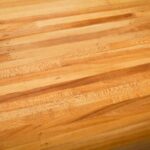Russian Olive Wood is a unique and lesser-known type of wood that has gained attention among woodworking enthusiasts. Known for its striking appearance and distinct characteristics, it has become a popular choice for those looking to add a touch of elegance to their woodworking projects. In this article, we will delve into the world of Russian Olive Wood, exploring its origins, properties, availability, pros and cons, as well as techniques for working with it.
Native to regions such as Russia, Central Asia, and Eastern Europe, Russian Olive Wood comes from the Russian olive tree (Elaeagnus angustifolia). This deciduous tree holds historical significance in these areas and is revered for its beauty and resilience. The wood itself boasts an intricate grain pattern that ranges from light yellow to dark orange-brown hues. Additionally, it possesses exceptional hardness and durability, making it an excellent choice for various woodworking applications.
When it comes to working with Russian Olive Wood, understanding its unique characteristics is essential. From its grain structure to its stability and workability qualities, this wood offers a distinctive experience for craftsmen. Whether you are an experienced woodworker or just starting out in the craft, exploring the different aspects of this remarkable wood will provide valuable insights into how to best utilize it in your projects.
In the following sections of this article, we will further explore the traits and properties of Russian Olive Wood while discussing its availability and sourcing methods. We will also weigh the pros and cons of using this wood in woodworking projects compared to other types of wood commonly used by craftsmen. Furthermore, we’ll dive into methods for finishing and maintaining Russian Olive Wood to enhance its natural beauty while considering sustainability aspects associated with its usage.
Characteristics of Russian Olive Wood
Russian Olive wood, also known as Oleaster, is a hardwood with unique characteristics that make it a desirable choice for woodworking projects. This section will delve into the various traits and properties that make Russian Olive Wood distinct.
Color and Grain Pattern
One of the most striking features of Russian Olive Wood is its beautiful coloration and grain pattern. The heartwood ranges from light yellow to golden brown, often displaying dark streaks or contrasting bands of darker brown. These patterns give the wood a distinctive appearance and make it visually appealing for furniture making, turning, and other woodworking applications.
Density and Strength
Russian Olive Wood has a moderate density, making it sturdy and durable for woodworking projects. It has a Janka hardness rating of around 1,300 pounds-force (lbf), which is comparable to well-known hardwoods such as cherry or oak. This makes Russian Olive Wood strong enough to withstand wear and tear, making it suitable for items that may experience daily use or heavy handling.
Stability and Workability
While Russian Olive Wood is considered to be moderately stable in terms of movement due to changes in humidity or temperature, proper drying techniques can enhance its stability for woodworking projects. The wood generally works well with both hand tools and machinery, although care should be taken when working with figured or interlocked grain patterns to prevent tearouts.
Overall, the unique characteristics of Russian Olive Wood, including its color and grain pattern, density and strength, as well as its stability and workability, contribute to its desirability in woodworking projects. Whether used for furniture, flooring, or decorative items, this wood offers a visually appealing option that can withstand the test of time.
In the next section of this article, we will discuss the availability of Russian Olive Wood and where to find it for your woodworking needs.
Availability and Sourcing
Russian Olive Wood is a unique and sought-after material in the woodworking community, known for its beautiful grain patterns and warm tones. However, finding Russian Olive Wood can be a challenge due to its limited availability. This section will discuss the availability of Russian Olive Wood and provide information on where to source it.
Due to its specific geographic origin, Russian Olive Wood is primarily found in parts of Eastern Europe and Central Asia. The tree itself is native to regions such as Russia, Kazakhstan, and Mongolia. As a result, the availability of Russian Olive Wood can vary depending on your location.
When it comes to sourcing Russian Olive Wood, there are a few options to consider. Local specialty lumberyards or hardwood suppliers may occasionally carry this wood, but it’s important to note that their stock levels may be limited. Additionally, artisan woodworkers or craftsmen who specialize in using exotic woods may have some Russian Olive Wood available for purchase.
Another convenient option is to explore online retailers or marketplaces that specialize in exotic woods. These platforms often have a wider range of wood species available, including Russian Olive Wood. When purchasing online, it’s advisable to check the seller’s reputation and reviews to ensure you are getting high-quality wood.
It’s worth noting that due to its limited availability, Russian Olive Wood can be relatively expensive compared to more common types of wood used in woodworking projects. However, many enthusiasts find the beauty and unique characteristics of this wood well worth the investment.
Pros and Cons of Russian Olive Wood
Russian Olive Wood, like any other type of wood, comes with its own set of pros and cons when it comes to woodworking projects. Understanding these advantages and disadvantages can help woodworkers make informed decisions about whether or not to use Russian Olive Wood in their projects.
Advantages
One of the key advantages of Russian Olive Wood is its beautiful appearance. It features a rich, warm color with intricate grain patterns that can add a unique and distinctive look to any woodworking project. The wood has an attractive natural luster that can be enhanced with a proper finish.
In addition to its aesthetics, Russian Olive Wood is known for its durability. It is a dense hardwood that is resistant to decay and insect damage, making it an ideal choice for outdoor furniture or structures that need to withstand harsh weather conditions. Its strength also makes it suitable for functional items such as cutting boards or tool handles.
Furthermore, Russian Olive Wood is readily available in some regions, which can make sourcing it easier compared to other rare or exotic types of wood. This availability may vary depending on location and local regulations regarding the harvesting and trade of Russian Olive trees.
Disadvantages
While there are many advantages to using Russian Olive Wood, there are also some drawbacks to consider. Firstly, due to its density and hardness, working with Russian Olive Wood can be challenging. It may require sharp tools and more effort during shaping, drilling, or carving.
Another disadvantage is that Russian Olive trees are considered invasive species in certain areas. They can displace native vegetation and negatively impact ecosystems. Therefore, some environmental organizations discourage the use of this wood in order to prevent further spread of the tree species.
Lastly, cost may be a factor for some woodworkers considering Russian Olive Wood. Depending on availability and demand, prices for this type of wood can vary significantly compared to more commonly used woods such as oak or pine.
Considering these pros and cons, woodworkers must carefully evaluate their specific project requirements, personal preferences, and environmental concerns before deciding whether or not to use Russian Olive Wood in their woodworking endeavors.
Uses of Russian Olive Wood
Russian Olive Wood is a versatile material that can be used in a wide range of woodworking projects. Its unique characteristics and properties make it particularly suitable for certain applications where its durability, visual appeal, and stability shine through.
One of the primary uses of Russian Olive Wood is in furniture making. The wood’s dense grain structure and high strength make it an excellent choice for crafting sturdy tables, chairs, and cabinets. Additionally, its beautiful grain patterns and warm hues add a touch of elegance to any piece of furniture.
Another popular application for Russian Olive Wood is in turning projects. The wood’s density allows it to be turned on a lathe with ease, resulting in smooth finishes and intricate details. Items such as bowls, vases, pens, and other decorative objects can be expertly crafted from Russian Olive Wood, showcasing its natural beauty.
Due to its strong resistance to moisture and decay, Russian Olive Wood is also ideal for outdoor woodworking projects. This makes it a great choice for constructing decks, fences, pergolas, and other landscaping structures that need to withstand the elements. Its natural oils contribute to its longevity outdoors, making it highly resistant to rotting or warping over time.
When working with Russian Olive Wood, it’s important to consider the potential health risks associated with the wood’s dust particles. Like many types of hardwoods, breathing in the dust generated during sanding or cutting can cause respiratory issues. It is recommended to wear appropriate protective gear such as a dust mask or respirator when working with this wood.
| Applications | Examples |
|---|---|
| Furniture | Tables, chairs, cabinets |
| Turning Projects | Bowls, vases, pens |
| Outdoor Woodworking | Decks, fences, pergolas |
Working with Russian Olive Wood
Russian Olive Wood is known for its unique characteristics and beautiful grain patterns, making it a popular choice among woodworkers. However, working with this specific type of wood requires some special considerations to ensure the best results. Here are some tips and techniques for working with Russian Olive Wood:
- Sharp Tools: Due to its dense nature, Russian Olive Wood can be challenging to work with if your tools are not sharp enough. It is important to keep your blades and bits sharp to prevent any tear-out or chipping while cutting or shaping the wood.
- Slow and Steady: When milling or shaping Russian Olive Wood, it is essential to take your time and work slowly. This wood can be quite hard, so rushing through the process may result in splintering or uneven cuts. Take small passes with each cut and make sure to use a steady hand for better control.
- Pre-Drilling: When using screws or nails on Russian Olive Wood, pre-drilling is recommended. This helps prevent the wood from splitting due to its dense nature. Use a drill bit that is slightly smaller than the screw or nail you will be using to create pilot holes before fastening.
- Grain Orientation: Pay attention to the grain orientation when working with Russian Olive Wood, as it can have an impact on the overall strength and stability of your project. Consider how the wood will naturally expand and contract over time and align the grain accordingly for better longevity.
- Finishing Considerations: Before applying any finish to Russian Olive Wood, it is crucial to sand it thoroughly first. Due to its density, this wood may require more sanding than other types of wood to achieve a smooth surface. Additionally, because of its natural oils, some finishes may not adhere well, so it is advisable to test different finishes on scrap pieces before committing to one.
Overall, while working with Russian Olive Wood may present some challenges, the end result is worth the effort. Its unique properties and stunning appearance make it a worthwhile choice for various woodworking projects. With proper techniques and considerations, you can create beautiful and long-lasting pieces using this distinctive wood.
Finishing and Maintenance
Russian Olive Wood is known for its unique beauty and distinctive grain patterns, which make it a popular choice for woodworking projects. However, in order to enhance and preserve its natural beauty, proper finishing and maintenance techniques must be employed. Here are some recommendations for finishing and preserving Russian Olive Wood:
- Sanding: Before applying any finish, it is important to sand the wood surface smoothly. Start with a coarse grit sandpaper and gradually work your way up to finer grits to achieve a smooth finish. Pay extra attention to the end grain areas as they tend to absorb more finish.
- Stain or Natural Finish: Depending on your desired outcome, you can choose to apply a stain or leave the wood’s natural color exposed. If you decide to go for a stained look, choose an oil-based stain that complements the warm tones of Russian Olive Wood. Test the stain on a scrap piece of wood first to ensure you achieve the desired color before applying it onto your project.
- Sealant: Once you have achieved the desired color, it is crucial to seal the wood surface using an appropriate sealant. A polyurethane varnish or a Danish oil finish are two popular options for sealing Russian Olive Wood. Apply multiple thin coats of sealant, allowing each coat to dry completely before applying the next one.
- Routine Maintenance: To maintain the natural beauty of Russian Olive Wood over time, regular maintenance is necessary. Keep the wood away from direct sunlight and extreme temperature changes as they can cause fading and warping respectively. Use protective coasters or mats under hot dishes or glasses to prevent heat marks and water rings from forming on the surface.
Comparisons with other types of wood
Russian Olive Wood is often compared to other popular woods used in woodworking. It has its own unique characteristics that make it stand out from other types of wood. One key aspect that sets Russian Olive Wood apart is its distinct grain pattern. The swirling, interlocking grain of this wood creates beautiful and intricate patterns, giving it a unique aesthetic appeal.
In terms of hardness, Russian Olive Wood falls in the mid-range when compared to other woods. It is not as hard as hardwoods like oak or maple, but it is harder than softwoods like pine or cedar. This makes it suitable for a wide range of woodworking projects, from furniture to smaller decorative items.
When comparing Russian Olive Wood with other popular woods like mahogany or walnut, another important aspect to consider is the color. Russian Olive Wood typically has a medium golden brown hue with lighter streaks that can vary slightly depending on the tree’s age and growing conditions. This warm and inviting color adds an elegant touch to any woodworking project.
Another advantage of using Russian Olive Wood is its durability. This type of wood is known for its resistance to decay and rot, making it ideal for outdoor applications such as decking or garden furniture. Its natural oils also help protect the wood from moisture and pests, increasing its lifespan.
In comparison to other types of wood, one potential drawback of Russian Olive Wood is its scarcity. While it can be found in certain regions where the trees are more prevalent, it may not be as readily available as other common woods like oak or pine. However, many specialty lumber suppliers and online retailers offer Russian Olive Wood for purchase.
Overall, when contrasting Russian Olive Wood with other popular woods in woodworking, it becomes clear that it offers unique visual appeal with its distinctive grain pattern and warm coloration. Its durability and resistance to decay make it suitable for various projects both indoors and outdoors. Despite its limited availability, those who choose to work with Russian Olive Wood will have the opportunity to create stunning and long-lasting woodworking pieces.
Sustainability and Environmental Impact
Russian Olive Wood raises an important question regarding its sustainability and environmental impact. As with any type of wood used in woodworking, it is essential to consider where the wood comes from and how its production affects the environment. In the case of Russian Olive Wood, several factors contribute to both its ecological aspects and sustainability.
One aspect to consider is the invasive nature of Russian Olive trees. These trees are not native to many regions where they are now found, including parts of North America and Europe. They were introduced with good intentions as a means to control erosion, but they have since become invasive species that compete with native vegetation for resources. Harvesting Russian Olive Wood from these trees can help manage their spread and prevent further negative impacts on local ecosystems.
Another factor contributing to the sustainability of Russian Olive Wood is its growth rate. Russian Olives typically grow relatively quickly, allowing for faster regeneration rates than slower-growing woods like oak or walnut. This means that when responsibly harvested, Russian Olive Wood can be a more sustainable choice for woodworking projects compared to other types of wood.
It is worth noting that there are certain considerations when sourcing Russian Olive Wood sustainably. It is important to ensure that the wood is obtained legally and ethically by sourcing from reputable suppliers who practice responsible forestry management. This includes harvesting methods that minimize damage to surrounding vegetation and wildlife habitats, as well as supporting forest conservation efforts.
Conclusion
In conclusion, Russian Olive Wood offers a unique set of characteristics and properties that make it a great option for woodworking projects. Its distinct grain pattern, rich color, and natural durability contribute to its appeal. Additionally, Russian Olive Wood can be found in various sizes and cuts, making it suitable for different types of projects.
While there are some drawbacks to working with Russian Olive Wood, such as its hardness and potential for warping, these challenges can be overcome with proper techniques and considerations. Overall, the pros outweigh the cons when it comes to using this wood in woodworking.
Russian Olive Wood is versatile and can be used for a wide range of applications. It is particularly well-suited for furniture making, turning projects, and intricate carvings. Its stability also makes it an excellent choice for outdoor projects such as decks and fences.
When working with Russian Olive Wood, it is important to take certain precautions and use specific tools suited for hardwoods. Additionally, proper finishing techniques should be employed to enhance the wood’s natural beauty and preserve its longevity.
In terms of sustainability and environmental impact, harvesting Russian Olive Wood can actually be beneficial for ecosystems where it is considered invasive. By utilizing this wood in woodworking projects effectively reduces its negative impact on native plant species while providing a valuable resource.
Frequently Asked Questions
Is olive wood good for woodworking?
Olive wood is indeed a great choice for woodworking. Its dense and tight grain makes it durable and resistant to wear, which is highly desirable in woodworking projects. The wood’s natural warmth and beautiful grain patterns also make it visually appealing, adding a touch of elegance to finished creations.
Olive wood is known for its workability, making it relatively easy to shape, carve, and turn on a lathe. Woodworkers often appreciate olive wood for its unique qualities and versatility in various woodworking applications.
What can you do with Russian olive wood?
Russian olive wood presents several possibilities when it comes to its uses. First and foremost, it can be utilized in woodworking projects, just like regular olive wood. Craftsmen can create intricate furniture pieces, including tables, chairs, cabinets, and shelves using this type of wood.
Due to its decorative appearance with streaks of dark brown or greenish coloration intertwined with lighter hues, Russian olive wood is often employed for accents or details in smaller wooden items as well. Beyond traditional woodworking applications, the attractive nature of the wood lends itself well to creating ornamental objects such as bowls, vases, cutting boards, or even decorative carvings.
Is olive wood prone to cracking?
While olive wood possesses many remarkable qualities ideal for woodworking projects, it does typically have some susceptibility to cracking. As with any type of lumber or timber, there are factors that can influence the likelihood of cracking in olive wood. One significant factor is the moisture content within the wood; if dried too quickly or unevenly during the seasoning process, cracking may occur more readily.
Additionally, changes in humidity levels can cause olive wood to expand and contract, potentially leading to cracks over time if not properly addressed or stabilized during construction. However, with appropriate drying techniques and precautions taken by knowledgeable craftsmen using proper methods like sealing or applying finishes that assist in preventing moisture absorption or loss can help mitigate potential cracking issues associated with olive wood.

Hi everyone! I’m a woodworker and blogger, and this is my woodworking blog. In my blog, I share tips and tricks for woodworkers of all skill levels, as well as project ideas that you can try yourself.





